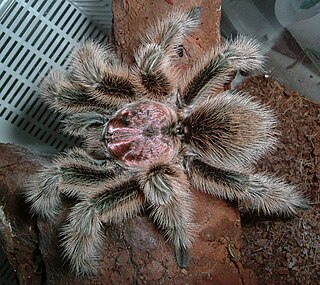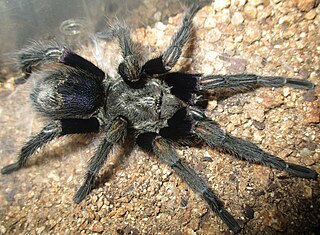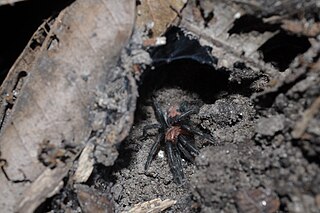
Grammostola is a genus of South American tarantulas that was first described in text by Eugène Louis Simon in 1892. These medium- to large-sized spiders are native to tropical South America, and are usually brown in color, with pinkish or orangish-red hairs. The very docile Chilean rose tarantulas are popular as a beginner's spider among tarantula enthusiasts.
Bryantella is a genus of jumping spiders that was first described by Arthur Merton Chickering in 1946. As of June 2019 it contains only two species, found only in Brazil, Argentina, and Panama: B. smaragda and B. speciosa. This genus was named in honour of Elizabeth B. Bryant.

Pamphobeteus is a genus of tarantulas that was first described by Reginald Innes Pocock in 1901. It includes some of the largest spiders in the world. They are found in South America, including the countries of Peru, Bolivia, Ecuador, Brazil, Colombia and Panama.

Euathlus is a genus of South American tarantulas that was first described by Anton Ausserer in 1875. These spiders are medium sized and are usually found in high elevations in the Andes. It is a senior synonym of Paraphysa, and was formerly considered a senior synonym of Brachypelma, but this was later rejected.

Cyriocosmus is a genus of tarantulas that was first described by Eugène Louis Simon in 1903. They are small to medium spiders, with a bicolored or one same color carapace.

Davus pentaloris is a species of New World tarantula native to Mexico and Guatemala. Davus was at one time considered to be a synonym of Cyclosternum, and its species were placed in that genus, but this is no longer accepted.
Cyclosternum is a genus of tarantulas that was first described by Anton Ausserer in 1871.

Lasiodora is a genus of tarantulas that was first described by Ludwig Carl Christian Koch in 1850. They are often very large; body lengths of up to 25 centimetres (9.8 in), including the legs, are not unusual. They are found in Central and South America, including the countries of Argentina, Brazil, Bolivia, Costa Rica and Uruguay.

Holothele is a genus of tarantulas that was first described by Ferdinand Anton Franz Karsch in 1879. Originally placed with the curtain-web spiders, it was transferred to the tarantulas in 1980.

Thrixopelma is a genus of South American tarantulas that was first described by Günter E. W. Schmidt in 1994. They are medium to large tarantulas, usually being 35mm to 60mm in body length.
Bymainiella is a genus of Australian funnel-web spiders that was first described by R. J. Raven in 1978. This genus is named in honour of the Australian arachnologist Barbara York Main.

Xenesthis is a genus of tarantulas that was first described by Eugène Louis Simon in 1891. As of May 2020 it contains four species, found in Colombia and Venezuela, though it was previously considered to be found in Panama.
Entypesa is a genus of African mygalomorph spiders in the family Entypesidae. It was first described by Eugène Louis Simon in 1902. Originally placed with the curtain-web spiders, it was transferred to the funnel-web trapdoor spiders in 1985, then to the Entypesidae in 2020. It is a senior synonym of Pseudohermacha.
Melognathus is a monotypic genus of southeast Asian tarantulas containing the single species, Melognathus dromeus. It was erected in 1917 for a holotype collected from a ship that visited southeast Asia. In 1985, the species was moved to Cyriopagopus because the autapomorphies were not considered significant enough to warrant a new genus. Opinions between biologists were split, some using the original name and some using Cyriopagopus. In a 2019 report, Gabriel and Sherwood pointed out that in addition to the differences in pedipalp morphology, the holotype exhibits leg features that indicate an arboreal species, while species of Cyriopagopus are largely terrestrial. The ambiguous location of the holotype has left room for speculation, but as of February 2022 the World Spider Catalog accepts this genus.
Eurypelmella is a nomen dubium for a genus of spiders in the family Theraphosidae. It has been regarded as a synonym for Schizopelma, but this was disputed in 2016.
Rick C. West is a Canadian arachnologist and an expert on the taxonomy of tarantula spiders. West was born in Victoria, British Columbia. He has been interested in spiders since childhood, and collected his first tarantula, Aphonopelma eutylenum, at the age of 13. He worked primarily as a Chief Constable for a local Animal Humane Society, but also have been involved with the collecting, breeding, rearing and photography of theraphosid spiders. West has traveled to over 27 countries to document and study them in their environment, has been a host, presenter and co-producer in several tarantula documentaries and has also described several genera and species.

Hapalopus coloratus is a species of tarantula found in Panama. It was first described by Carlos E. Valerio in 1982 as Metriopelma coloratum. It was transferred to the genus Hapalopus in 2016.
Staveleya is a genus of European sheet weavers. Its current name is a replacement for Hypsocephalus, already a genus in the snapper family of fish. The type species was originally described under the name "Microneta pusilla", but the type species is designated one of the junior synonyms, "Cnephalocotes dahli" because it has a physical specimen. The genus is named in honour of Eliza Fanny Staveley, the first woman to publish research on arachnology in the United Kingdom.
Thunberga is a genus of east African huntsman spiders. The genus was first described by Peter Jäger in 2020, and it has only been found on Madagascar and on Mayotte. It is named after the environmental activist Greta Thunberg.
Cymbiapophysa is a genus of spiders in the family Theraphosidae, first described by Pocock, in 1903, as of 2022 it contains 4 species. The tarantulas of this genus inhabit Central America. Males of this genus can be distinguished by the presence of a distal retrolateral apophysis on the cymbium of the male pedipalp. And females can be distinguished with twin spermathecae, by the morphology and the short and squat receptacles.









